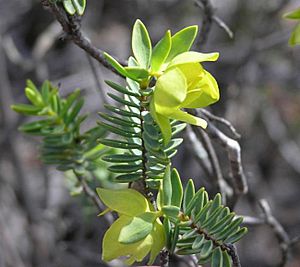Pimelea aeruginosa facts for kids
Quick facts for kids Pimelea aeruginosa |
|
|---|---|
 |
|
| Scientific classification | |
| Genus: |
Pimelea
|
| Species: |
aeruginosa
|
Pimelea aeruginosa is a special kind of small shrub that grows in Western Australia. It's known for its pretty yellow flowers and is found only in this part of the world. This plant belongs to a family of plants called Thymelaeaceae.
Contents
What Does It Look Like?
Pimelea aeruginosa is a small, upright shrub that can grow from about 20 centimeters (8 inches) to 1.5 meters (5 feet) tall. It has smooth stems.
Its leaves grow in pairs, one across from the other. They are usually narrow and shaped a bit like an egg, or wider at the top. The leaves are smooth and all one color, about 7 to 22 millimeters long and 2.5 to 7.5 millimeters wide. They sit very close to the stem.
The plant's yellow flowers grow in bunches that hang downwards. These flower clusters have many flowers packed closely together. Each cluster is surrounded by special leaf-like parts called bracts. These bracts are usually in groups of 3 to 6 pairs. They are broad and rounded, about 11 to 25 millimeters long and 7 to 17 millimeters wide. They are smooth, but sometimes the inner ones might be yellowish with tiny hairs on their edges.
The individual flowers are shaped like tubes, about 11 to 15 millimeters long and are smooth. Inside the flower, the style (a part of the female reproductive organ) is about 8 to 11 millimeters long. The sepals (small leaf-like parts that protect the flower bud) are about 3 to 3.5 millimeters long. They are smooth or have a few hairs along their middle line. The stamens (the male parts of the flower) can be shorter or longer than the sepals.
This plant usually blooms, or flowers, from May to October.
How It Got Its Name
Discovery and Naming
The plant Pimelea aeruginosa was first officially described in 1869. A scientist named Ferdinand von Mueller gave it its scientific name. He published his description in a book called Fragmenta Phytographiae Australiae.
The second part of its name, aeruginosa, comes from a Latin word meaning "verdigris". Verdigris is a greenish-blue color that forms on copper. This name was chosen because of the color of the flower bracts when they dry.
Where It Grows
Habitat and Location
You can mostly find Pimelea aeruginosa growing inland from a city called Geraldton, all the way down to Esperance in Western Australia.
It likes to grow in sandy soil, gravel, or sandy clay. Often, it's found in areas where the soil has a hard layer underneath called laterite. These areas are usually covered with a type of bushland called mallee, which has many small, multi-stemmed eucalyptus trees.

